Histone H4 (Acetyl Lys16) Polyclonal Antibody
- Catalog No.:YK0014
- Applications:WB;IHC;IF;ELISA
- Reactivity:Human;Mouse;Rat
- Target:
- Histone H4
- Fields:
- >>Neutrophil extracellular trap formation;>>Alcoholism;>>Viral carcinogenesis;>>Systemic lupus erythematosus
- Gene Name:
- HIST1H4A/HIST1H4B/HIST1H4C/HIST1H4D/HIST1H4E/HIST1H4F/HIST1H4H/HIST1H4I/HIST1H4J/HIST1H4K/HIST1H4L/HIST2H4A/HIST2H4B/HIST4H4
- Protein Name:
- Histone H4
- Human Swiss Prot No:
- P62805
- Mouse Gene Id:
- 1.00041e+008
- Mouse Swiss Prot No:
- P62806
- Rat Gene Id:
- 1.00361e+008
- Rat Swiss Prot No:
- P62804
- Immunogen:
- The antiserum was produced against synthesized peptide derived from human Histone H4 around the acetylated site of Lys16. AA range:1-50
- Specificity:
- Acetyl-Histone H4 (K16) Polyclonal Antibody detects endogenous levels of Histone H4 protein only when acetylated at K16.
- Formulation:
- Liquid in PBS containing 50% glycerol, 0.5% BSA and 0.02% sodium azide.
- Source:
- Polyclonal, Rabbit,IgG
- Dilution:
- WB 1:500-2000, IHC 1:50-300, IF 1:50-300
- Purification:
- The antibody was affinity-purified from rabbit antiserum by affinity-chromatography using epitope-specific immunogen.
- Concentration:
- 1 mg/ml
- Storage Stability:
- -15°C to -25°C/1 year(Do not lower than -25°C)
- Other Name:
- HIST1H4A;H4/A;H4FA;HIST1H4B;H4/I;H4FI;HIST1H4C;H4/G;H4FG;HIST1H4D;H4/B;H4FB;HIST1H4E;H4/J;H4FJ;HIST1H4F;H4/C;H4FC;HIST1H4H;H4/H;H4FH;HIST1H4I;H4/M;H4FM;HIST1H4J;H4/E;H4FE;HIST1H4K;H4/D;H4FD;HIST1H4L;H4/K;H4FK;H4k16AC
- Observed Band(KD):
- 11kD
- Background:
- Histones are basic nuclear proteins that are responsible for the nucleosome structure of the chromosomal fiber in eukaryotes. Two molecules of each of the four core histones (H2A, H2B, H3, and H4) form an octamer, around which approximately 146 bp of DNA is wrapped in repeating units, called nucleosomes. The linker histone, H1, interacts with linker DNA between nucleosomes and functions in the compaction of chromatin into higher order structures. This gene is intronless and encodes a replication-dependent histone that is a member of the histone H4 family. Transcripts from this gene lack polyA tails but instead contain a palindromic termination element. This gene is found in the histone microcluster on chromosome 6p21.33. [provided by RefSeq, Aug 2015],
- Function:
- function:Core component of nucleosome. Nucleosomes wrap and compact DNA into chromatin, limiting DNA accessibility to the cellular machineries which require DNA as a template. Histones thereby play a central role in transcription regulation, DNA repair, DNA replication and chromosomal stability. DNA accessibility is regulated via a complex set of post-translational modifications of histones, also called histone code, and nucleosome remodeling.,PTM:Acetylation at Lys-6, Lys-9, Lys-13 and Lys-17 occurs in coding regions of the genome but not in heterochromatin.,PTM:Citrullination at Arg-4 by PADI4 impairs methylation.,PTM:Monomethylated, dimethylated or trimethylated at Lys-21. Monomethylation is performed by SET8. Trimethylation is performed by SUV420H1 and SUV420H2 and induces gene silencing.,PTM:Monomethylation at Arg-4 by PRMT1 favors acetylation at Lys-9 and Lys-13. Demethylation is p
- Subcellular Location:
- Nucleus. Chromosome.
- Expression:
- B-cell lymphoma,Bone marrow,Brain,Clones donated by HIP,Corpus call
Dietary sulforaphane inhibits histone deacetylase activity in B16 melanoma cells. Journal of Functional Foods 2015 Jul 28 WB Human,Mouse B16 melanoma cell,U251 cell
Ube2v1-mediated ubiquitination and degradation of Sirt1 promotes metastasis of colorectal cancer by epigenetically suppressing autophagy. Journal of Hematology & Oncology J Hematol Oncol. 2018 Dec;11(1):1-16 WB Human DLD-1 cell, SW480 cell
Mof acetyltransferase inhibition ameliorates glucose intolerance and islet dysfunction of type 2 diabetes via targeting pancreatic α-cells. MOLECULAR AND CELLULAR ENDOCRINOLOGY Mol Cell Endocrinol. 2021 Nov;537:111425 WB Mouse 1:1000 Liver
Ube2v1-mediated ubiquitination and degradation of Sirt1 promotes metastasis of colorectal cancer by epigenetically suppressing autophagy. Journal of Hematology & Oncology J Hematol Oncol. 2018 Dec;11(1):1-16 WB Human DLD-1 cell, SW480 cell
Synergistic action by multi-targeting compounds produces a potent compound combination for human NSCLC both in vitro and in vivo. Cell Death & Disease 2014 Mar 20 WB Human H460/TaxR cell
The elevated transcription of ADAM19 by the oncohistone H2BE76K contributes to oncogenic properties in breast cancer. JOURNAL OF BIOLOGICAL CHEMISTRY 2021 Jan;296: WB Human 293T cell,MDA-MB-231 cell
- June 19-2018
- WESTERN IMMUNOBLOTTING PROTOCOL
- June 19-2018
- IMMUNOHISTOCHEMISTRY-PARAFFIN PROTOCOL
- June 19-2018
- IMMUNOFLUORESCENCE PROTOCOL
- September 08-2020
- FLOW-CYTOMEYRT-PROTOCOL
- May 20-2022
- Cell-Based ELISA│解您多样本WB检测之困扰
- July 13-2018
- CELL-BASED-ELISA-PROTOCOL-FOR-ACETYL-PROTEIN
- July 13-2018
- CELL-BASED-ELISA-PROTOCOL-FOR-PHOSPHO-PROTEIN
- July 13-2018
- Antibody-FAQs
- Products Images
.jpg)
- Kang, Tze Zhen Evangeline, et al. "The elevated transcription of ADAM19 by the oncohistone H2BE76K contributes to oncogenic properties in breast cancer." Journal of Biological Chemistry 296 (2021).
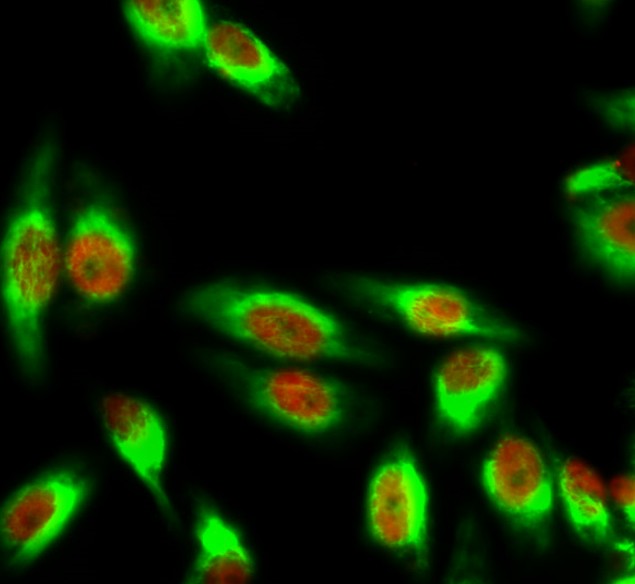
- Immunofluorescence analysis of Hela cell. 1,Histone H4 (Acetyl Lys16) Polyclonal Antibody(red) was diluted at 1:200(4° overnight). α-tubulin Monoclonal Antibody(8F11)(green) was diluted at 1:200(4° overnight). 2, Goat Anti Rabbit Alexa Fluor 594 Catalog:RS3611 was diluted at 1:1000(room temperature, 50min). Goat Anti Mouse Alexa Fluor 488 Catalog:RS3208 was diluted at 1:1000(room temperature, 50min).
poly-ihc-human-breast-cancer.jpg)
- Immunohistochemical analysis of paraffin-embedded Human-breast-cancer tissue. 1,Histone H4 (Acetyl Lys16) Polyclonal Antibody was diluted at 1:200(4°C,overnight). 2, Sodium citrate pH 6.0 was used for antibody retrieval(>98°C,20min). 3,Secondary antibody was diluted at 1:200(room tempeRature, 30min). Negative control was used by secondary antibody only.
poly-ihc-human-liver-cancer.jpg)
- Immunohistochemical analysis of paraffin-embedded Human-liver-cancer tissue. 1,Histone H4 (Acetyl Lys16) Polyclonal Antibody was diluted at 1:200(4°C,overnight). 2, Sodium citrate pH 6.0 was used for antibody retrieval(>98°C,20min). 3,Secondary antibody was diluted at 1:200(room tempeRature, 30min). Negative control was used by secondary antibody only.
poly-ihc-human-lung.jpg)
- Immunohistochemical analysis of paraffin-embedded Human-lung tissue. 1,Histone H4 (Acetyl Lys16) Polyclonal Antibody was diluted at 1:200(4°C,overnight). 2, Sodium citrate pH 6.0 was used for antibody retrieval(>98°C,20min). 3,Secondary antibody was diluted at 1:200(room tempeRature, 30min). Negative control was used by secondary antibody only.
poly-ihc-human-kidney-cancer.jpg)
- Immunohistochemical analysis of paraffin-embedded Human-kidney-cancer tissue. 1,Histone H4 (Acetyl Lys16) Polyclonal Antibody was diluted at 1:200(4°C,overnight). 2, Sodium citrate pH 6.0 was used for antibody retrieval(>98°C,20min). 3,Secondary antibody was diluted at 1:200(room tempeRature, 30min). Negative control was used by secondary antibody only.
poly-ihc-human-stomach-cancer.jpg)
- Immunohistochemical analysis of paraffin-embedded Human-stomach-cancer tissue. 1,Histone H4 (Acetyl Lys16) Polyclonal Antibody was diluted at 1:200(4°C,overnight). 2, Sodium citrate pH 6.0 was used for antibody retrieval(>98°C,20min). 3,Secondary antibody was diluted at 1:200(room tempeRature, 30min). Negative control was used by secondary antibody only.
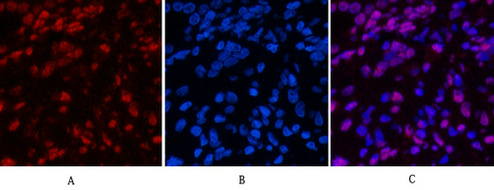
- Immunofluorescence analysis of Human-kidney tissue. 1,Histone H4 (Acetyl Lys16) Polyclonal Antibody(red) was diluted at 1:200(4°C,overnight). 2, Cy3 labled Secondary antibody was diluted at 1:300(room temperature, 50min).3, Picture B: DAPI(blue) 10min. Picture A:Target. Picture B: DAPI. Picture C: merge of A+B
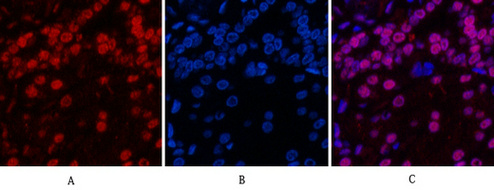
- Immunofluorescence analysis of Human-kidney tissue. 1,Histone H4 (Acetyl Lys16) Polyclonal Antibody(red) was diluted at 1:200(4°C,overnight). 2, Cy3 labled Secondary antibody was diluted at 1:300(room temperature, 50min).3, Picture B: DAPI(blue) 10min. Picture A:Target. Picture B: DAPI. Picture C: merge of A+B
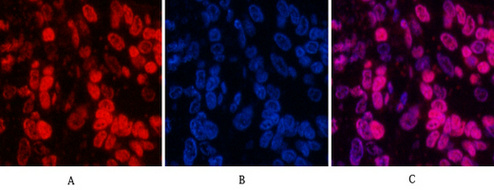
- Immunofluorescence analysis of Human-lung-cancer tissue. 1,Histone H4 (Acetyl Lys16) Polyclonal Antibody(red) was diluted at 1:200(4°C,overnight). 2, Cy3 labled Secondary antibody was diluted at 1:300(room temperature, 50min).3, Picture B: DAPI(blue) 10min. Picture A:Target. Picture B: DAPI. Picture C: merge of A+B
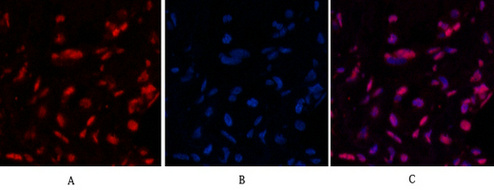
- Immunofluorescence analysis of Human-lung tissue. 1,Histone H4 (Acetyl Lys16) Polyclonal Antibody(red) was diluted at 1:200(4°C,overnight). 2, Cy3 labled Secondary antibody was diluted at 1:300(room temperature, 50min).3, Picture B: DAPI(blue) 10min. Picture A:Target. Picture B: DAPI. Picture C: merge of A+B

- Western Blot analysis of various cells using Acetyl-Histone H4 (K16) Polyclonal Antibody. Secondary antibody(catalog#:RS0002) was diluted at 1:20000
.jpg)
- Western Blot analysis of KB cells using Acetyl-Histone H4 (K16) Polyclonal Antibody. Secondary antibody(catalog#:RS0002) was diluted at 1:20000
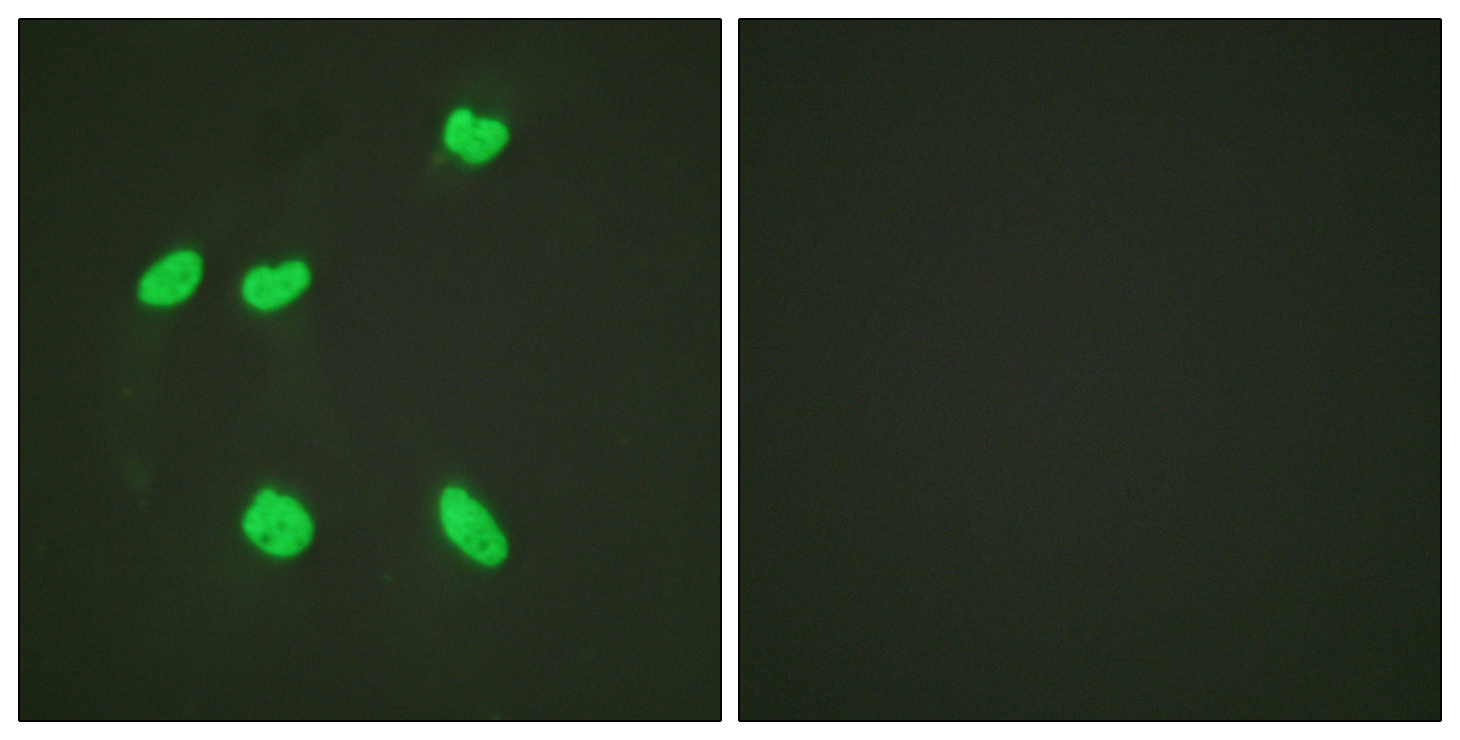
- Immunofluorescence analysis of HeLa cells, using Histone H4 (Acetyl-Lys16) Antibody. The picture on the right is blocked with the synthesized peptide.
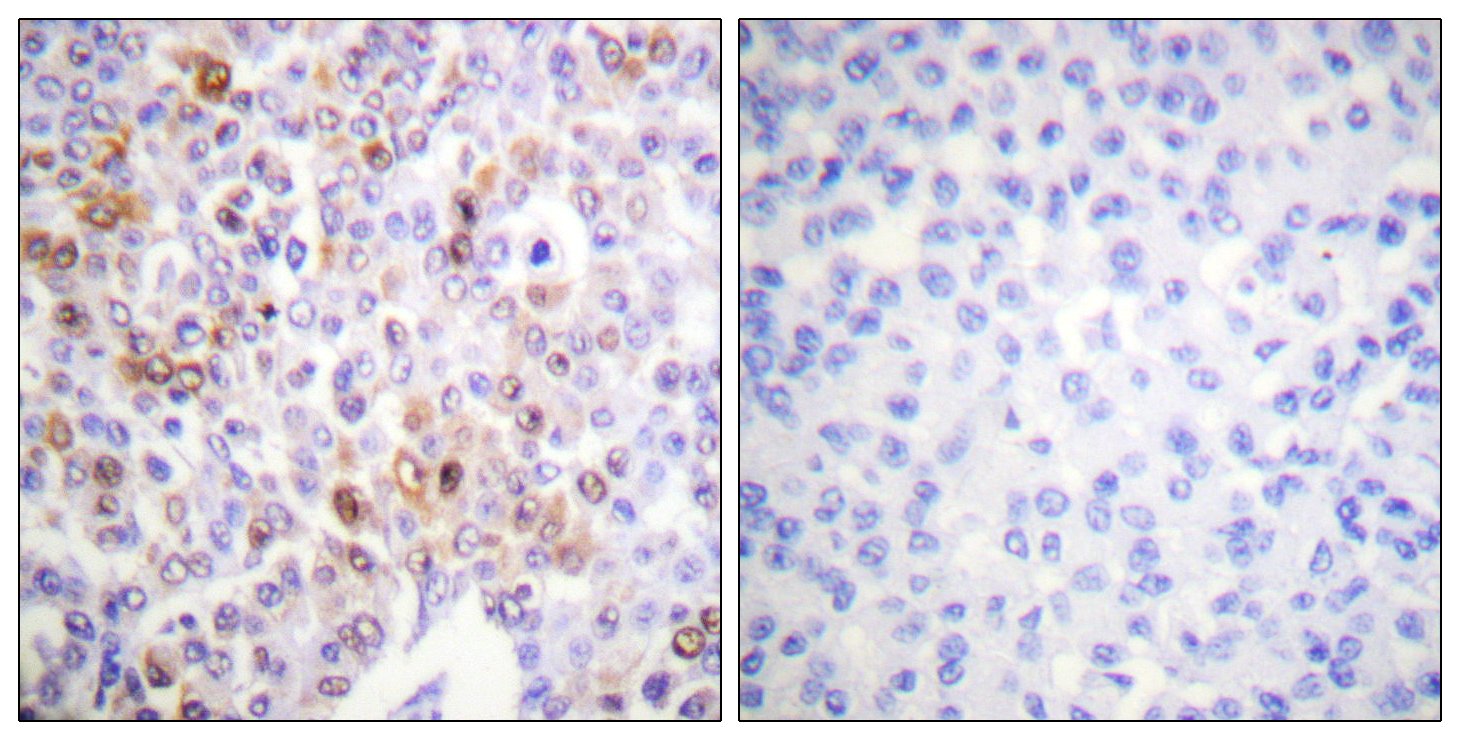
- Immunohistochemistry analysis of paraffin-embedded human breast carcinoma tissue, using Histone H4 (Acetyl-Lys16) Antibody. The picture on the right is blocked with the synthesized peptide.



